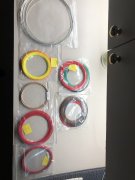The HP 6228 Dual tracking power supply ($37 + shipping/tax = $112.47 to the door) arrived from Arizona today. Here's what I received:
View attachment 59615
(0-50vdc, 1 amp x 2 channels)
But wait, there's more! Shortly after I found a slightly different HP 62xx series power supply on offer -- a 622
7, which offers a 0-25vdc,
2 amp output x 2. A little less voltage, but a little more grunt, looked like a good fit for what I have in mind down the road. A little more spendy at the asking price of ~$120, (but the seller knocked a little off) the shipping was only $36, and of course the 8% NY state tax = $146.90 to the door.) It was so clean, looked like somebody owned it at home vs. just being used in a manufacturing production environment by employees.
And what tipped me over the edge was the very neat, very cool DYMO label on it. So here is my lab-to-be's 2nd power supply:
View attachment 59616
(0-25vdc, 2 amp x 2 channels)
Total damage to the piggy bank for
both power supplies is $259.37.
IMHO, this compares favorably to this clean (single) HP power supply on eBay today, listed for $395.00 + shipping:
View attachment 59617
Of course we'll see if I'm still smiling after I rummage through both units & see what it's going to take to bring them back to trustworthy status. :0)
Happy New Year to all my fellow audio enthusiasts here in the Phoenix PL forum!
Cheers -

